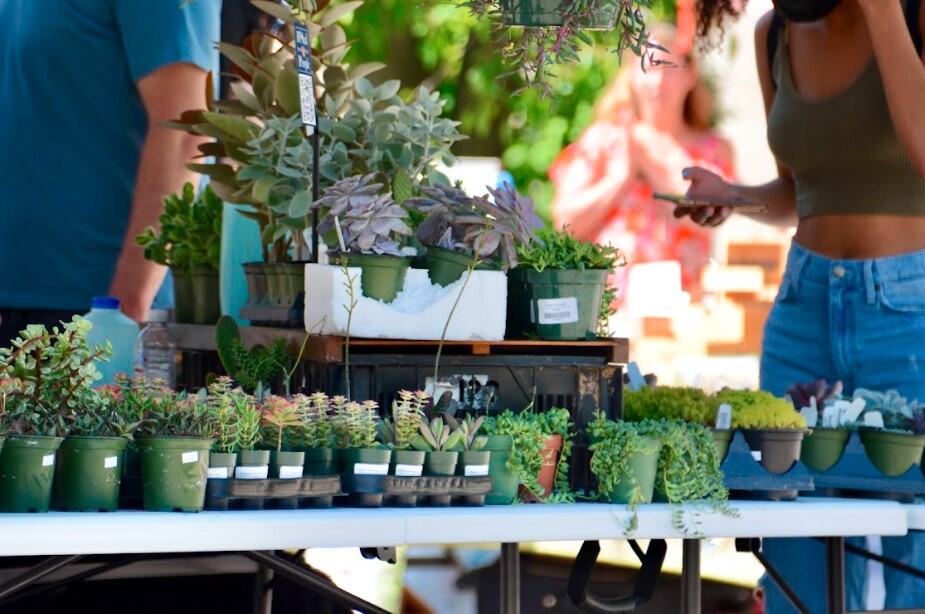The Art of Flea Market Selling: 20 Strategies to Earn More Money
Trying to get rid of some stuff around the house or planning to start a small business venture?
Decided to try your hand at flea markets?
Whether you’re a beginner or an experienced vendor, follow these crucial steps to achieve success and make more money when selling at flea markets.
Here’s a quick overview for you:
- Is it worth selling at flea markets?
- 17 Profitable items to sell at flea markets
- 20 Tips to sell at flea markets and make more money
Is it worth selling at flea markets?
It depends on your approach. If you’re considering it as a business, you should treat it like one.
Flea markets can be lucrative if you have the right products and can attract a steady flow of customers. It offers a platform to showcase unique, vintage, or handmade items, connecting sellers with niche markets.
You get a flexible, low-cost entry point and a great way to gauge market response for your products. However, success depends on key factors like location, product quality, pricing, and effective marketing. It may not provide a stable income, but as a side hustle or passion project, it offers a chance to turn your hobbies into profit.
17 Profitable items to sell at flea markets
Unique and high-quality items always stand out in the crowd. You can also capitalize on the current market and consumer trends to increase your sales.
Here are some of the best products you can sell at flea markets:
- Vintage and antique goods, like clothing, jewelry, furniture, and collectibles, often have a solid following at flea markets. People love unique, retro items.
- There’s a market for handmade crafts like soaps, candles, artwork, or knitwear.
- Refurbished electronics, old gaming consoles, or vintage tech gadgets can attract tech enthusiasts and collectors. Along with that, you can sell vintage board games, puzzles, and strategy games.
- Decorative items like artwork, vases, and home furnishings can be popular too.
- Vintage or high-quality hand tools, gardening equipment, and power tools.
- Collectibles like coins, stamps, postcards, and others can attract hobbyists and collectors. Unusual or rare items often do well.
- Plants and gardening supplies like potted plants, seeds, and tools can be profitable, especially during gardening season.
- Kitchenware, such as cast iron cookware, glassware, and utensils, can be popular among collectors and home cooks.
- Rare books, vintage vinyl records, and other media.
- Toys, board games, and action figures often have a strong following.
- Depending on the time of year, selling seasonal items like holiday decorations, swimsuits, or winter gear can be lucrative.
- Vintage or designer handbags, scarves, belts, and sunglasses.
- Used sports gear, such as bicycles, golf clubs, or fitness equipment.
- If you have pet-related items like pet carriers, toys, or unique pet accessories, you can tap into the pet lover market.
- Musical instruments like guitars, keyboards, and others can appeal to music lovers.
- Specialty food items like gourmet foods, homemade jams, and other unique edible products can attract customers.
- Selling quality makeup, skincare products, and perfumes can be profitable, especially if they’re in-demand brands.
Ensure you have a good idea to get a sense of what sells well in your specific area. Additionally, offer a mix of products to cater to different tastes and budgets to boost your overall profitability.
Check out this article if you want to find profitable flea market items for inspiration.
20 Tips to sell at flea markets and make more money
With simple tips and planning, you can succeed and ensure customer delight while selling at flea markets. Here’s how:
Find the right flea market to sell at
The first step is all about location, location, location. Find a flea market that suits your niche. If you’re selling vintage clothing, seek out markets known for their retro charm. Look for events that attract artsy crowds if you’re into handmade crafts.
Do your research and pick a flea market that aligns with your products and target audience. It definitely makes all the difference!
Meet local sellers and vendors
Meet local sellers and learn what markets work and what they like to sell. Knowing local sellers in the flea market is a treasure trove of knowledge and experience.
Strike up conversations, share your interests, and ask for advice. Ask them about the top categories that sell well, current trends, the best days and times to set up shop, and maybe some valuable tips.
Try new things and test your ideas. Either you earn more and learn something new. Plus, it’s always good to make connections that can help your business grow.
Keep your paperwork handy
We all agree that paperwork is not an exciting part of any business. But it’s vital to stay on the right side of the law. So ensure your business is registered with all the necessary permits or licenses, and make sure you’re compliant with local regulations.
This sounds tedious, but it’s a small price to pay for peace of mind, and it’s worth it!
Draw the crowd with eye-catching signage and labels
The next and key part of selling at the flea market is drawing traffic.

Use eye-catching and informative signs that showcase your prices, offers, and products. Remember, simple is often better – shoppers appreciate a quick glance over a lengthy read. Use clear, large fonts, and bright colors, and display your business name prominently.
A little creativity here can go a long way in making your booth stand out from the crowd and luring in potential buyers.
Price your products right
Let’s get down to the nitty-gritty – pricing your products. You should price your products so you stay profitable after all the expenses. It includes product price, operational expenses, and additional costs, including fees to set up your booth and marketing expenses.
Find that sweet spot where you’re making a profit and customers feel like they’re getting a deal. Take a look at what similar items are going for in the market, consider the quality and uniqueness of your offerings, and factor in your costs.
Flea markets are all about bargaining, so you should be ready to negotiate and strike a win-win deal.
Arrive early
Most shoppers who buy at flea markets are early birds. They look for deals and discounts. So ensure you arrive there at least an hour or two before the schedule.
Sell multiple products – Showcase your best ones
Customers look for variety and deals in the flea markets! So offer a range of items that cater to different tastes and budgets. But here’s the trick: make sure to highlight your best and most eye-catching products. These are your showstoppers, the ones that stop people in their tracks. Use them to draw customers to your booth, and then once they’re there, they’re bound to discover other gems in your collection.
Don’t let the weather take you by surprise
Stay informed of the forecast and ensure you weatherproof your flea market booth. For instance, during rainy days, invest in sturdy, waterproof canopies or tents to shield your merchandise and customers from rain. Similarly, plan ahead for excessive heat, and protect your delicate items in case they need extra care.
Also, dress appropriately for the climate. In colder seasons, layer up to stay warm, while in hot weather, wear light, breathable clothing. Comfortable attire allows you to be more attentive to customers’ needs.
Lastly, keep a weather emergency kit on hand with essentials like first-aid supplies, flashlights, a portable charger, and any necessary tools for quick fixes or adjustments.
Determine your inventory
Inventory is one of the most important parts of your business. You don’t want to run out of popular items halfway through the day, nor do you want to be stuck with a pile of unsold goods when it’s time to pack up. Plan ahead and estimate how much quantity you need. Keep an eye on what’s selling and what’s not, and be prepared to adapt.
Get your essentials
After inventory, It’s time to set the stage for your flea market success. Tables, shelving, extension cords, mirrors (if you’re selling clothes, accessories, or beauty products), props, and everything else that you need to display and sell your items attractively.
Make your booth visually appealing. Get creative with your setup; use vintage crates, tablecloths, or whatever suits your style. You don’t have to overdo it and keep it minimal.
The key here is to make your booth inviting to your audience. The more organized your booth looks, the more likely shoppers are to stop by and make a purchase. So plan how you want your shop to look.
Clear out the clutter
This is an extension of the previous point. It’s essential to get creative with your booth, but you should keep your selling space tidy and organized. A decluttered environment helps you create more space for customers to move around, browse, and buy your items. It also helps you maintain a professional and polished appearance, which can boost your credibility as a seller. Additionally, use color codes to group items, and find ways to bundle them so you can find opportunities to upsell and increase average order value.
Also, determine how you organize your booth even when you have limited items. A half-empty booth wouldn’t leave a great impression on the shoppers.
Offer different payment methods
Some sellers usually accept cash, Venmo, or PayPal to avoid additional fees. But while selling at a flea market, set up different payment methods to offer your customers convenience. Raise your prices to accommodate any additional fees you might incur to set up payment methods. We suggest you accept cash, Venmo Business, PayPal, Square, CashApp, and others.
Carry cash with you
Ensure you start with at least $100-$200 cash in hand because you’ll need to give change to customers who pay you in cash.
Also, it has a lot to do with the price of your products. Try to price your items in multiples of $1, $5, or $ 10 to avoid dealing with cents.
Let’s say your product is priced around $9. You should carry a lot of $1. If your item costs around $15, ensure you carry a lot of five dollars.
Keep your cash secured
You need to carry cash with you to the flea market. However, having a lot of cash in hand could attract unwanted attention. So ensure you have an apron close to your body, a fanny pack, or something that is good enough to help you secure the cash.
The most important part – Traffic
More customers (traffic) = More sales = More profits

This is true if you have the right products and marketing mix. To convert foot traffic into sales, you should have products that meet the customers’ needs and the way you market them.
We already discussed investing in eye-catching signage and organizing your products to upsell. Have business cards or digital business cards readily available for customers. Include your contact information and social media details to encourage repeat business.
Establish online presence
Most people sell at flea markets for the fun of it or as a side hustle. However, it’s good to see the big picture as well. If you want to grow your business further, you should establish an online presence. You can do this by creating your own website, Shopify store, or business Instagram account.
Consider running a campaign or promotion on Google or social media, where you can gather customer information. Using this information, you can also sell your stuff to them.
Branding your flea market business
This is an extension of the previous point. Branding your flea market business is a strategic and creative way to establish your stall’s unique and memorable identity. It’s not just about a logo and a catchy name – it’s about finding what sets you apart in the competitive world of flea market selling.
Determine what sets your business apart. This could be unique products, exceptional quality, a specific style, or outstanding customer service. You should add storytelling and share why you started selling at flea markets and the inspiration behind your products, and use them as part of your marketing and social media presence. Make your experiences relatable to your audience so your brand leaves an unforgettable impact on them.
Be active and spontaneous
Flea markets are all about your salesmanship (with a good product base, though). So stay active and engaging at your flea market booth. Greet passersby with a welcoming smile and invite them to explore your offerings. Avoid the temptation of simply sitting at your table, absorbed in your own world.
Also, be open to negotiations, as many shoppers come expecting these interactions. Know your lowest acceptable prices for items in advance and maintain a friendly and accommodating attitude during negotiations. It’s all part of the fun of the flea market experience.
For families shopping with kids, consider offering small goodies like balloons or lollipops. These gestures not only keep the little ones content and occupied but also draw families to your booth, enhancing their overall shopping experience.
Customer service is the key
Providing excellent customer service, being approachable, and having an appealing booth setup can further boost your sales. In today’s age, staying connected with your customers is important.
Their reviews serve as social proof for your business. In that context, encourage customers to leave feedback or reviews about your products and services if you have an online presence. Positive testimonials can build trust and attract more customers.
Diversify your revenue streams
Most sellers selling at flea markets are probably doing it as a side hustle or selling their products online on eBay or other sales channels. So don’t forget that you can expand and diversify your income streams.
I hope you find these 20 valuable tips helpful. Use them to elevate your flea market selling game, increase your earnings, and turn your booth into a thriving business venture.
Happy selling!






